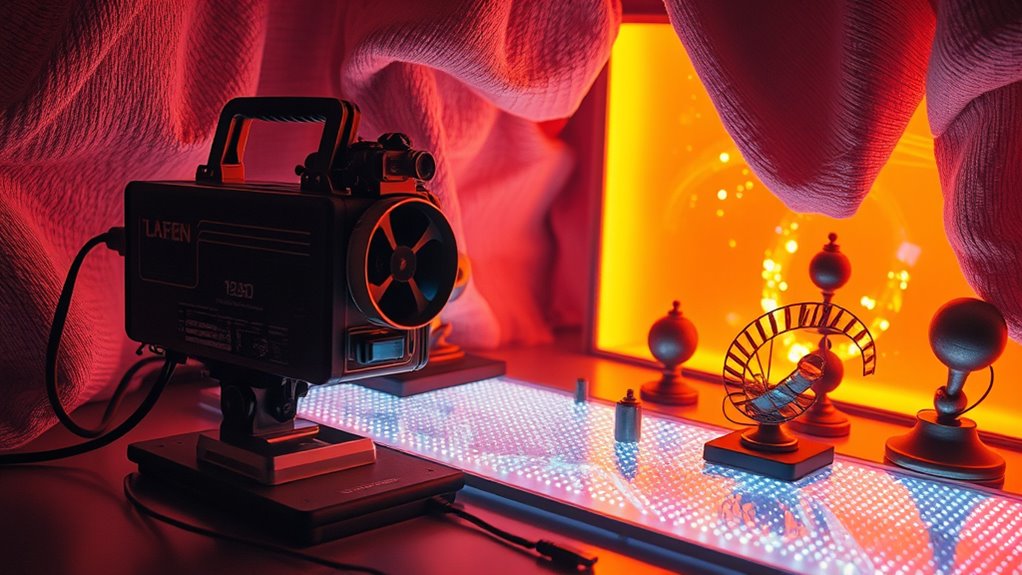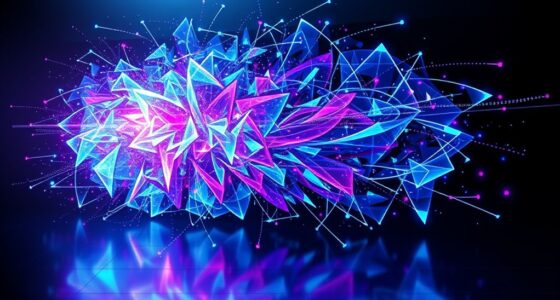Hybrid media art combines traditional physical practices with digital technologies to craft immersive, interactive experiences. You’ll see how artists blend materials like textiles or organic matter with sensors, projections, or digital components, creating layered works that engage multiple senses. This approach blurs the lines between physical and digital worlds, inviting your active participation and perception shifts. If you’re curious about how these innovative creations reshape artistic boundaries, there’s more to explore beyond this overview.
Key Takeaways
- Hybrid media art integrates traditional physical materials with digital technologies to create immersive, multisensory experiences.
- It enables interactivity, allowing viewers to influence visuals and sounds through physical actions.
- Artists experiment with combining organic and synthetic materials, pushing boundaries of material and digital integration.
- The fusion of tangible objects and digital components produces layered narratives and unique textures.
- This approach fosters seamless dialogue between physical and digital worlds, expanding artistic expression and audience engagement.

Hybrid Media Art combines traditional artistic practices with digital and technological innovations, creating immersive and interactive experiences. When you dive in this field, you’ll find that artists often blend physical materials with digital media to craft works that engage multiple senses and invite active participation. One of the most captivating aspects of hybrid media art is its use of interactive installations. These installations transform passive viewers into active participants, allowing you to manipulate digital projections, sensors, or physical components to influence the artwork. For example, you might step into a space where your movements trigger visuals on screens or change sounds in real time, blurring the line between observer and creator. This interactivity heightens your engagement, making the experience personal and dynamic.
Material experimentation plays a essential role in hybrid media art. Artists push the boundaries of traditional media by combining unexpected materials with digital components. Think about integrating organic matter like plants or textiles with sensors or projections to create living, breathing artworks. This experimentation can lead to surprising textures and forms that challenge your perception of art’s physical and conceptual limits. By exploring different materials—metal, plastic, fabric, or even biodegradable substances—artists find new ways to communicate ideas and evoke emotions. The tactile quality of material experimentation invites you to consider how physicality interacts with digital elements, fostering a deeper connection with the work.
As you explore hybrid media art, you’ll notice how artists often leverage both the tangible and intangible qualities of their materials. For instance, a piece might combine a physical sculpture with embedded LEDs that respond to your presence or sound. This fusion not only enhances aesthetic appeal but also creates a layered narrative that you can explore from multiple angles. Material experimentation often involves testing new techniques, such as 3D printing combined with traditional craft, to produce unique textures or forms that wouldn’t be possible with one medium alone. This approach encourages you to appreciate the craftsmanship behind the digital elements and see the physical materials as essential parts of the artistic statement.
In essence, hybrid media art invites you to experience a seamless dialogue between the physical and digital worlds. Interactive installations make you an active participant, while material experimentation pushes the boundaries of what art can be. You might also find that some works draw inspiration from the global entertainment industry, blending popular culture with avant-garde techniques to reach diverse audiences. By engaging with these works, you become part of an evolving conversation about technology, creativity, and perception, where each element—be it digital code or handcrafted material—contributes to a richer, more immersive artistic experience.
Frequently Asked Questions
How Does Hybrid Media Art Influence Audience Engagement?
You experience heightened audience interaction through hybrid media art, as it seamlessly blends analog and digital elements. This combination invites you to participate actively, encouraging emotional responses that deepen your connection with the artwork. By engaging multiple senses and offering dynamic experiences, hybrid media art makes you feel more involved, fostering a memorable and impactful encounter. It transforms passive observation into an immersive, emotionally resonant journey.
What Are the Technical Challenges in Blending Analog and Digital Media?
You face technical challenges in blending analog and digital media, mainly in technical integration and preservation techniques. Ensuring seamless connection between diverse hardware and software can be complex, often requiring specialized skills. Preservation techniques are vital to maintain the quality and longevity of both media types, as digital formats may become obsolete, and analog materials can degrade over time. Overcoming these challenges demands careful planning and technical expertise.
How Do Artists Protect Their Hybrid Media Works From Digital Piracy?
Think of your hybrid media work as a treasure chest; you guard it with digital watermarking, embedding subtle signatures that identify your ownership. To prevent piracy, you actively enforce copyright laws, monitoring online platforms for unauthorized use. These tools act like digital guards, helping you protect your creative treasure from theft, ensuring your unique blend of analog and digital art remains yours and yours alone.
What Are the Future Trends in Hybrid Media Art Development?
You’ll see future hybrid media art evolve with more immersive Augmented Reality experiences and sophisticated Interactive Installations. Artists are likely to blend physical and digital elements seamlessly, creating engaging, multisensory environments. Expect advancements in real-time interaction, personalized content, and enhanced interactivity that break traditional boundaries. These trends will make hybrid media art more accessible and enthralling, encouraging you to explore new dimensions of creative expression through innovative technology integrations.
How Can Hybrid Media Art Be Integrated Into Educational Settings?
You can integrate hybrid media art into educational settings by designing interactive workshops that engage students in hands-on experiences. Research shows that students involved in creative technology learn 30% faster, making it a valuable addition. Incorporate hybrid media art into your curriculum by blending analog and digital tools, encouraging experimentation and innovation. This approach fosters critical thinking, creativity, and digital literacy, preparing students for future technological landscapes.
Conclusion
Think of hybrid media art as a vibrant tapestry woven from both the warmth of analog threads and the bright sparks of digital innovation. By blending these worlds, you create a seamless dance between tradition and technology, inviting viewers into a constantly evolving universe. Embrace this fusion, and you’ll uncover new creative horizons—where past and future collide in a beautiful symphony. In this art form, you’re the conductor guiding the harmonious blend of old and new.










